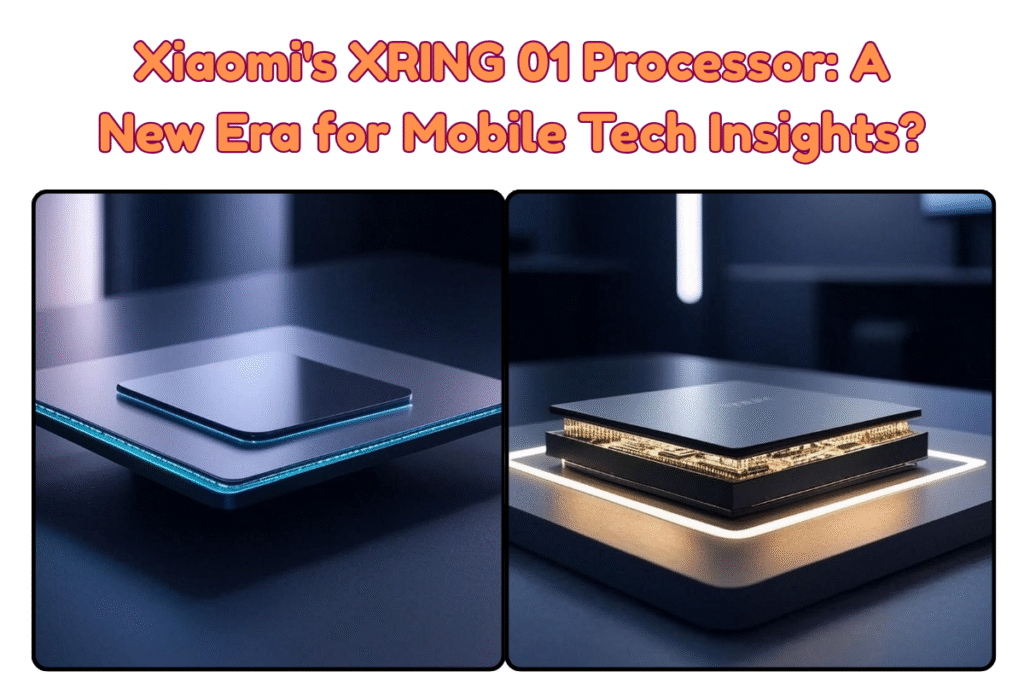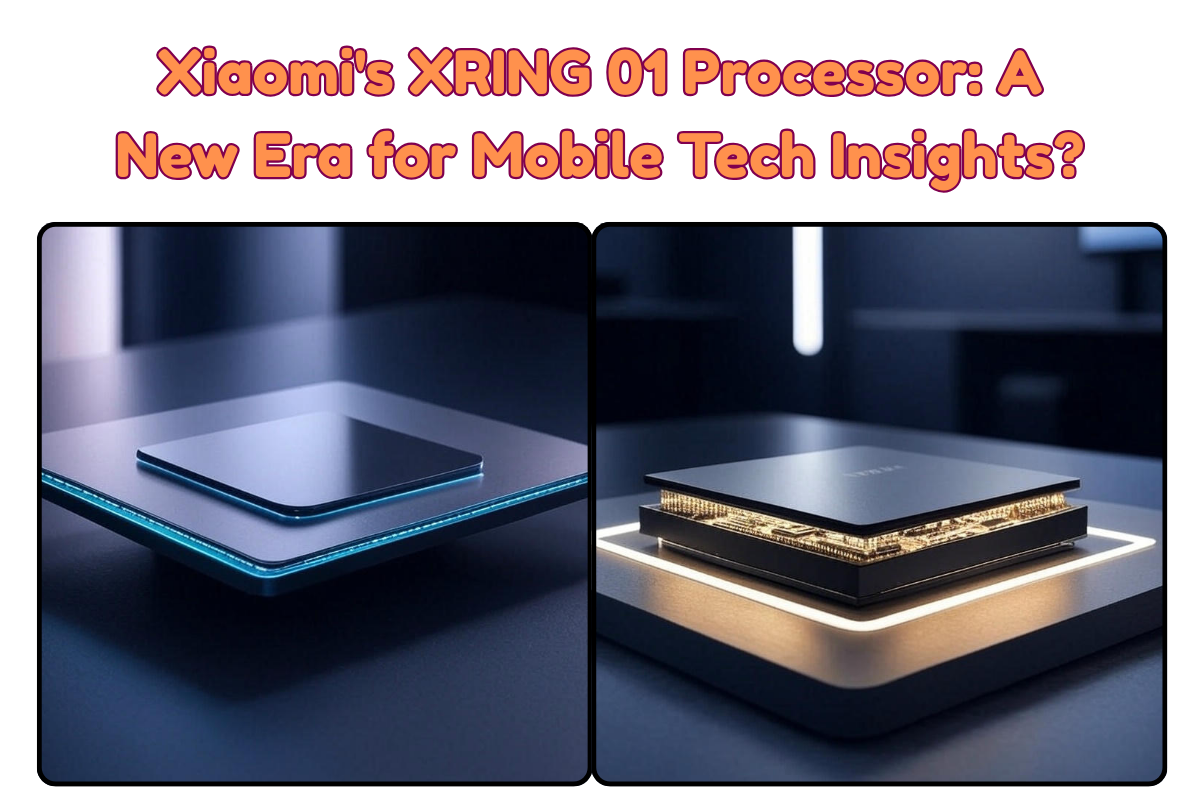In the fast-paced world of smartphones, the processor is the heart of the device. It dictates performance, efficiency, camera capabilities, and ultimately, the user experience. For years, manufacturers like Qualcomm and MediaTek have dominated the mobile chipset landscape, powering the vast majority of Android devices. However, a significant shift has been underway, with more and more companies seeking to develop their own silicon. This isn’t just about control over the supply chain; it’s about deep integration, tailored performance, and carving out a unique identity in a crowded market. For those keenly following Mobile Tech insights, the recent confirmation from Xiaomi regarding the imminent unveiling of their homegrown XRING 01 processor is a pivotal moment.
This isn’t Xiaomi’s first foray into chip design – they previously launched the Surge S1, a mid-range SoC, and the Surge C1 and P1 imaging and charging chips. But the XRING 01 appears to signal a more ambitious move, potentially targeting a broader range of functions or even acting as a co-processor alongside a main SoC. What does this mean for Xiaomi’s future devices, and how will it impact the competitive mobile tech landscape? Let’s delve into the potential implications of this exciting development.
The Strategic Advantage of Homegrown Silicon

Why are companies like Apple, Google, Huawei (before restrictions), and now increasingly others, investing heavily in designing their own chips? The reasons are multifaceted and offer significant strategic advantages:
- Tailored Performance and Efficiency: Designing a chip specifically for your hardware and software allows for unparalleled optimization. You can fine-tune performance cores, graphics processing units (GPUs), and specialized accelerators (like AI or image signal processors) to perfectly match the intended use cases of your devices. This often leads to better performance-per-watt compared to using off-the-shelf solutions.
- Deeper Integration: A custom chip allows for seamless integration with other components and the operating system. This can unlock unique features, improve overall system responsiveness, and provide a more cohesive user experience.
- Control Over the Roadmap: Relying on external suppliers means your product development timeline is tied to theirs. Designing your own chip gives you complete control over the features, performance targets, and manufacturing schedule, allowing for faster innovation and differentiation.
- Cost Reduction (Potentially): While the initial investment in R&D is massive, in the long run, producing your own chips can potentially reduce per-unit costs, especially at scale.
- Differentiation: In a market where many phones share similar core components, a unique processor can be a major selling point and contribute to brand identity.
Xiaomi’s move with the XRING 01 suggests they are aiming for some, if not all, of these advantages. It’s a clear signal of their long-term commitment to the premium segment and their desire to have more control over their destiny in the mobile tech space.
XRING 01
As of now, official details about the XRING 01 are limited, building anticipation for the official unveiling. However, based on industry trends, past Xiaomi chip efforts, and leaks/rumors, we can form some educated guesses and highlight what to look for.
- Focus Area: The name “XRING” could hint at a focus on specific technologies. “XR” often refers to Extended Reality (AR/VR/MR), suggesting the chip might have capabilities tailored for these emerging areas. “RING” could imply connectivity, ecosystem integration, or perhaps a circular design element related to the technology.
- Type of Chip: Given Xiaomi’s previous Surge C1 (ISP) and P1 (charging) chips, the XRING 01 might be a specialized co-processor rather than a full-fledged SoC like a Snapdragon or Dimensity. A co-processor could handle specific tasks like image processing, AI computations, security, or connectivity, working alongside a main processor from Qualcomm or MediaTek. This approach allows Xiaomi to differentiate key aspects of their phone’s performance without the immense challenge of building a competitive main SoC from scratch.
- Potential Applications: If it’s an XR-focused chip, we might see it debut in devices with advanced AR features, potentially integrated into their camera systems or future wearable tech. If it’s a more general co-processor, it could enhance performance or efficiency in areas like photography, gaming, or power management across a range of their upcoming smartphones.
- Performance Targets: For a co-processor, performance would be measured by its efficiency and speed in handling its specific tasks, rather than overall benchmark scores like a main CPU. If it’s an ISP, look for improvements in image quality, processing speed, and new camera features. If it’s an AI chip, expect faster and more accurate AI-driven features.
The true nature and capabilities of the XRING 01 will only be revealed at the official launch, but its existence underscores Xiaomi’s ambition to control key technological components within their devices.
Comparison
Directly comparing the XRING 01 to full-fledged SoCs like the Snapdragon 8 Gen 3 or MediaTek Dimensity 9300 might be apples and oranges if XRING 01 is a co-processor. However, we can compare its potential impact and functionality to the specialized components within those competitor chips or to other companies’ co-processors.
| Feature Type | Xiaomi XRING 01 (Speculative) | Qualcomm Snapdragon 8 Gen 3 (Integrated) | MediaTek Dimensity 9300 (Integrated) | Apple A17 Pro (Integrated/Co-processors) | Potential Advantage for XRING 01 (If Specialized) |
|---|---|---|---|---|---|
| Primary Function | Specialized Co-processor (e.g., ISP, AI, XR) | Full SoC (CPU, GPU, ISP, AI, Modem) | Full SoC (CPU, GPU, ISP, AI, Modem) | Full SoC + Dedicated Co-processors | Deep specialization and optimization for its task |
| Performance Focus | Efficiency and speed in specific tasks (e.g., photo) | Overall balanced performance | Overall balanced performance | Highly optimized for Apple ecosystem | Potentially outperform integrated components in its niche |
| Integration | Deep integration with Xiaomi hardware/software | Standard integration with Android | Standard integration with Android | Deep integration with Apple ecosystem | Tailored performance for Xiaomi devices |
| Differentiation | Unique selling point for Xiaomi devices | Standard component across many brands | Standard component across many brands | Key differentiator for Apple | Helps Xiaomi stand out from competitors |
| Development Cost | High (for the specific chip) | Very High (for the full SoC) | Very High (for the full SoC) | Extremely High (for the full SoC + ecosystem) | More manageable than building a full SoC |
Note: This comparison is highly speculative based on the assumption that XRING 01 is a specialized co-processor. If it turns out to be a full SoC, the comparison would be different.
If the XRING 01 is indeed a specialized chip, its success won’t be measured by topping benchmark charts for overall performance. Instead, its value will lie in how significantly it enhances specific aspects of the user experience – perhaps enabling groundbreaking camera features, delivering unprecedented efficiency for XR applications, or providing a level of security or connectivity not possible with off-the-shelf components.
Key Insights from Xiaomi’s Chip Ambitions

Xiaomi’s persistent efforts in developing their own silicon, culminating in the XRING 01, offer several key Mobile Tech insights:
- The Drive for Differentiation: In a mature smartphone market, hardware specifications alone are becoming less effective at differentiating products. Companies are increasingly looking to custom silicon to provide unique capabilities and performance advantages that competitors cannot easily replicate.
- Vertical Integration is Key: Following the path of successful tech giants like Apple, more companies are realizing the benefits of controlling both the hardware and software layers, enabled by custom silicon. This allows for tighter integration and a more optimized product.
- Focus on Specialized Processors: Building a competitive flagship SoC is incredibly complex and expensive. A more achievable and potentially impactful strategy for many companies is to develop specialized co-processors that enhance specific, high-value functions like imaging, AI, or security. The XRING 01 might be an example of this trend.
- China’s Growing Chip Ambitions: Xiaomi is a major player in the global smartphone market, and their investment in chip design also reflects a broader push within China to reduce reliance on foreign semiconductor technology and build domestic capabilities.
- Raising the Bar for Competition: As more companies develop custom silicon, it will likely push traditional chip manufacturers like Qualcomm and MediaTek to innovate faster and offer more compelling integrated solutions to remain competitive. This is ultimately beneficial for consumers.
The XRING 01 is more than just a new piece of silicon; it represents Xiaomi’s strategic direction and their commitment to elevating their position in the global tech industry through technological self-reliance and innovation.
The Potential Impact on Xiaomi Devices

The introduction of the XRING 01 could have a tangible impact on the performance and features of future Xiaomi smartphones and potentially other devices in their ecosystem.
- Enhanced Photography: If XRING 01 is an advanced ISP, expect significant improvements in image processing speed, low-light performance, dynamic range, and potentially new computational photography features.
- Improved AI Performance: A dedicated AI co-processor could accelerate AI tasks on the device, leading to faster voice recognition, improved scene detection in cameras, more personalized user experiences, and efficient on-device machine learning.
- Optimized XR Experiences: If the “XR” in XRING is a direct indicator, this chip could power more immersive and responsive augmented or virtual reality features within Xiaomi’s devices.
- Greater Efficiency: By offloading specific tasks to a specialized, efficient co-processor, the main SoC can conserve power, potentially leading to better battery life for those specific use cases.
- Unique Features: The XRING 01 could enable features that are exclusive to Xiaomi devices, providing a clear differentiator in the market.
The success of the XRING 01 will ultimately depend on how well it is integrated into Xiaomi’s hardware and software and how noticeable the improvements are to the end user.
Conclusion
Xiaomi’s confirmation of the imminent XRING 01 unveiling marks a significant step in their journey towards greater technological independence and innovation. While the exact nature and capabilities of the chip remain to be fully revealed, it signals Xiaomi’s ambition to move beyond being solely an assembler of components and to become a key developer of core mobile technology.
Whether it’s a specialized co-processor enhancing specific functions like imaging or XR, or a more foundational chip, the XRING 01 is poised to influence the performance and features of future Xiaomi devices. This move aligns with broader Mobile Tech insights indicating a growing trend towards vertical integration and the development of custom silicon for differentiation and optimized performance. The competition among tech giants to control the silicon that powers their devices is intensifying, and Xiaomi is clearly positioning itself to be a stronger player in this evolving landscape. The unveiling of the XRING 01 is not just news for Xiaomi fans; it’s a development that holds implications for the entire mobile industry.
What do you hope to see from Xiaomi’s XRING 01 processor? Share your Mobile Tech insights and expectations in the comments below!

